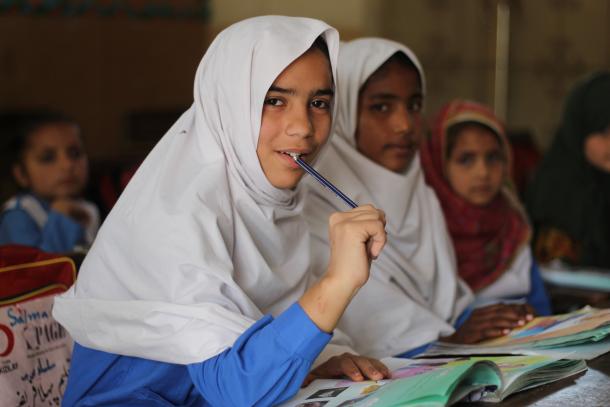By: Rachel Sammar
The International Day of the Girl Child, observed annually on October 11, brings global attention to the rights, challenges, and opportunities for girls worldwide. In Pakistan, where nearly half the population is female, the day highlights the urgent need to address the barriers that continue to impede progress for girls. Despite advancements, Pakistani girls face numerous obstacles, including limited access to education, healthcare, and protection from violence. Yet, there are promising signs of change as the country gradually works toward a more equitable future.
The day, established by the United Nations in 2011, emphasizes the critical need to promote girls’ empowerment and ensure their rights. It draws attention to issues such as child marriage, gender-based violence, and educational disparities. In Pakistan, where gender inequality is deeply entrenched, the day serves as a reminder of both the progress achieved and the challenges that remain.
One of the most significant issues facing girls in Pakistan is unequal access to education. According to UNICEF, over 22.8 million children are out of school in the country, with girls constituting the majority. In rural areas like Balochistan and Khyber Pakhtunkhwa, the gap in enrollment between boys and girls is striking. Factors such as cultural norms, poverty, and inadequate infrastructure contribute to this crisis. Many families prioritize boys’ education, viewing girls’ roles as primarily domestic, which perpetuates limited opportunities for women.
Child marriage is another pressing issue in Pakistan, with about 21% of girls married before the age of 18. The consequences of this practice are severe, affecting girls’ health, education, and economic prospects. Child brides are often forced to abandon their studies and face higher risks of domestic violence and health complications. Although Pakistan has laws to curb child marriage, such as the Child Marriage Restraint Act, enforcement remains weak, especially in rural areas where local customs often override national laws.
Violence and harassment continue to be pervasive threats to the safety of girls and women in Pakistan. Honor killings, domestic violence, and sexual harassment are widespread, with many cases going unreported due to the stigma attached to victims. Though laws like the Anti-Rape Ordinance of 2020 have been enacted to provide stronger protections, enforcement challenges persist, and the legal system often remains biased against women.
Access to healthcare is another critical issue for girls, particularly in rural and impoverished areas where basic services are scarce. Girls often lack access to vaccinations, nutrition, and maternal care. Cultural barriers further prevent many families from seeking medical help for their daughters. Pakistan’s high maternal mortality rate reflects the urgent need for better reproductive health services and education, areas that remain largely neglected in schools.
Despite these challenges, there are growing efforts to improve the situation for girls in Pakistan. Initiatives to expand girls’ access to education are gaining traction. Programs like the Benazir Income Support Program and Waseela-e-Taleem offer financial incentives for families to send their daughters to school. Organizations such as The Citizens Foundation are working to establish schools in underserved areas, with a focus on educating girls. Digital education initiatives, which have expanded during the COVID-19 pandemic, are also helping bridge gaps for girls who might otherwise be denied schooling due to geographic or cultural constraints.
On the legislative front, Pakistan has made strides with laws aimed at protecting girls’ rights, though enforcement remains a challenge. In addition to laws against child marriage and violence, Pakistan is a signatory to international agreements such as the Convention on the Elimination of All Forms of Discrimination Against Women (CEDAW). Provincial initiatives like the Punjab Protection of Women Against Violence Act aim to provide stronger legal protections for women and girls.
Cultural attitudes toward gender roles are also beginning to shift, albeit slowly. Media campaigns, advocacy by NGOs, and the visibility of female role models are challenging traditional norms. Figures like Malala Yousafzai, who has become a global symbol of girls’ education, exemplify the potential for change. Social media is increasingly providing a platform for girls to voice their concerns and connect with others, helping to raise awareness of gender issues in Pakistan.
The International Day of the Girl Child highlights the substantial challenges faced by girls in Pakistan, but it also offers hope for change. To make meaningful progress, a comprehensive approach is needed—one that addresses education, legal reform, healthcare, and societal attitudes. Investing in girls’ education, enforcing laws against child marriage and violence, and improving healthcare access are critical steps toward breaking the cycle of inequality. Empowering girls is not only a moral imperative but also essential for Pakistan’s broader development.
While the road to gender equality in Pakistan remains long, the growing awareness of girls’ rights and the gradual societal changes underway provide a basis for optimism. The International Day of the Girl Child serves as a call to action, urging all sectors of society to work toward a future where every girl in Pakistan has the opportunity to thrive and contribute to her community and nation.


